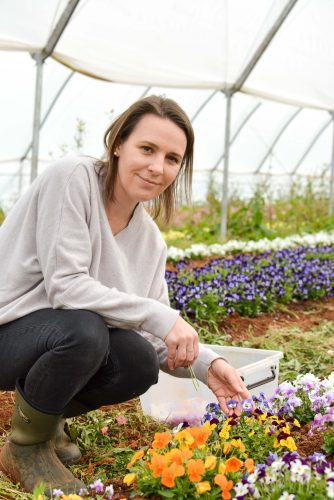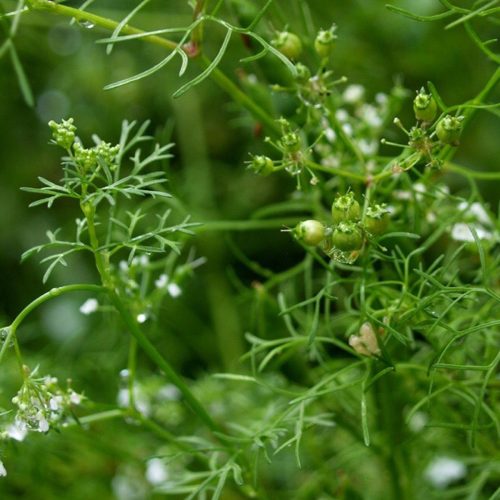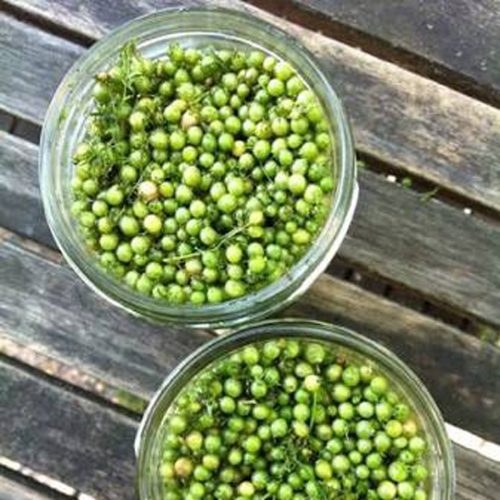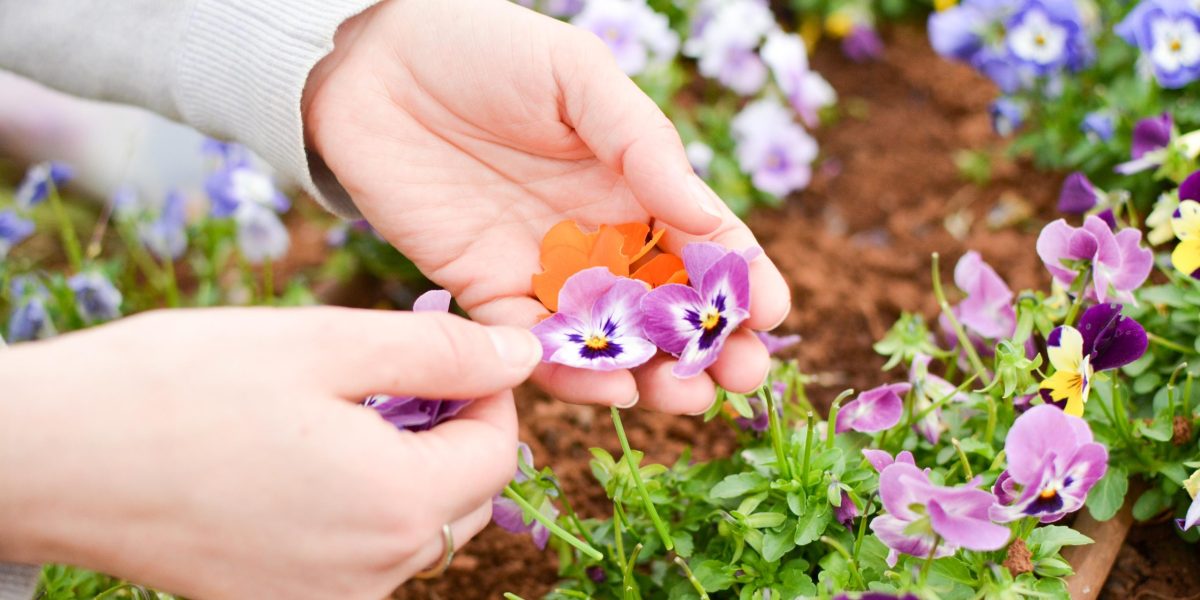The Principles Of Root To Bloom Eating
From plant stems to the greens of root vegetables, the reality is that a lot of what we routinely cook with simply goes to waste as we fail to recognise these ingredient leftovers are, in fact, perfectly good food. Jocelyn Cross, co-author of Root to Bloom: A Modern Guide to Whole Plant Use and founder of Petite Ingredient, specialising in the cultivation of organic edible flowers and leaves, shares with us an insight into her mission to raise awareness of the benefits of revising our perspective of edibility and, in turn, our notion of resourcefulness.
What springs to mind when we think of coriander is the pungent aroma of its abundant green leaves that add such a unique flavour to Asian dishes. In the nineties, this polarising herb was overpowering our home-cooked dishes but as our enthusiasm subdued, it became part of the everyday flavour vocabulary and coriander made its way into our herb gardens where we complained of its bad “bolting” habit. What we have failed to notice was what a hero of the herb garden coriander really is and that the flowers and the seeds that follow the root, stem and foliage have just as much to offer as their leafy forbearers.
Our preoccupation with perfection has narrowed our enjoyment of food. Like the choice cuts of meat on a beast, why do we only use one part of the plant? This linear way of thinking when it comes to yielding from the veggie garden, and the choices we make at the grocery store, is not only unadventurous but wasteful and unsustainable. Like the nose-to-tail slow food movement of the animal world, root to bloom eating explores the many benefits of cooking with the entire plant from the root to the flower, exploring new flavours and minimising food waste. It is a way of being more connected with the plants we eat – whether purchased or home-grown – inviting a more imaginative way of cooking seasonally from the vegetable garden.

The integrity of the preparation of our food inspires reflection and challenges our creativity – do you remember how our grandmothers, who lived through the Great Depression, made use of all their food? They had no choice but to use what they had and every part of it to feed their families. The intensity and thoughtless efficiency of modern farming has also meant a very narrow-minded list of ingredients make it to our plates. Our fixation on select cuts of meats and perfectly formed produce means that around 40 percent of food is either going in the bin or is left in the fields to rot.
With so many negative beliefs around stopping edible plants from going to flower and seed, we are ignoring that the many parts of a plant can provide greater flavour and new ingredients to your cooking. By shifting our perspective on what’s edible and by planning ahead – leaving your veggie garden to go to flower – we can benefit from the full course of a plant’s life, producing many other exciting ingredients. Then you will know the precious life of plants hasn’t gone to waste.
Root To Bloom heros you can grow at home
Citrus
I recently heard a caller on talk-back radio say, “if you have to buy lemons, then you mustn’t have any friends”. This caller was indeed correct; there is always a glut of lemons somewhere that’s worth sharing around, just like it’s always “five o’clock somewhere” in the world and therefore, entirely appropriate to imbibe that proverbial G&T with a wedge of lemon or lime.
The concept of the community lemon tree, and its abundant fruit shared with our neighbours, made me think about what root to bloom eating is all about. Did you know that the fruits and flowers (think orange blossom) are not the only edible parts? The leaves taste incredible wrapped around cheese or seafood over charcoal and citrus wood will add wonderful flavours to meat and fish when used for smoking. Citrus are my favourite fruits to preserve. Candied orange rind and preserved lemons are some of the best; sugar and salt not only preserve the fruits for months but intensify their flavours and add complexity and warmth to the fresh citrus tang. In my house, marmalade has always been a favourite on toast, especially when cumquats are used – their distinct tartness is unmatched.
Citrus trees are very easy to grow, whether you have a suburban garden large enough to house an ‘Eureka’ lemon tree, or a small terrace fit for a potted lime or cumquat; citrus will always pay you back in droves from very little of your effort.

Coriander
It’s no secret that I love this queen of the root to bloom movement. Not only is coriander super-easy to grow from seed (just throw some seed in the soil and you’ll have foliage in a few weeks) but for eternity, South-East Asian and Indian cooking has built entire cuisines around coriander’s distinctive flavour profile. You will often find its intensely flavoured roots ground to a paste and sauteed as a base to rice dishes and curries, or its raw leafy foliage as a garnish, but I really love using the flowers and the seeds in my kitchen. The flowers are even more aromatic than the foliage and pair beautifully with aniseed (great to finish off aniseed-flavoured desserts!) and can also be steeped in vodka and sugar to create a fresh summery cocktail. However, the jewel in the coriander crown has to be its seeds, which when dried, are one of the world’s most popular spices. The immature green coriander seeds are also a truly unique ingredient that I love to preserve in the warmer months.
Pickled Green Coriander Seeds

Makes approximately 375 ml (121⁄2 fl oz/11⁄2 cups)
Through the course of the coriander plant’s life, its flavours change and intensify. From the earthy, crisp roots to the fragrant foliage, coriander packs the biggest flavour punch towards the end of its life.
What’s great about pickling the seeds is how it mellows the coriander flavour, yet remains citrusy and herbaceous. At Oakridge Estate in the Yarra Valley, just up the road from our farm, chef Matt Stone (considered Australia’s leading sustainable chef) introduced me to pickled coriander seeds served with his liquorice-flavoured sorbet with blueberries and mousse. The warmth of these flavours infused with the sharp citrus crunch of the pickled green coriander seeds was incredible.
Use these pickled seeds whenever a dish would benefit from a citrusy note. They’re great in marinades, pastes for curries and salsa, and are perfect served with meat, fish and seafood.
Store the pickled seeds in the pantry and, once opened, store them in the refrigerator where they will keep indefinitely.
Recipe
170 ml (51⁄2 fl oz/2/3 cup) white-wine vinegar 1 tablespoon salt
100 g (31⁄2 oz/2 cups) freshly picked green coriander seeds
Use a saucepan large enough to hold two 500 ml (17 fl oz/2 cup) jars. Fill the saucepan with water and bring it to a simmer over medium heat.
Combine the vinegar and salt with 170 ml (51⁄2 fl oz/2/3 cup) water in another saucepan and bring to a simmer, stirring until the salt has dissolved.
Divide the coriander seeds between two sterilised 500 ml (17 fl oz/2 cup) glass jars (see page 14), then pour the hot brine over the seeds.
Wipe the rims of the jars and seal tightly with lids, then lower both jars into the hot water bath. Boil for 10 minutes, then transfer the jars to a wire rack and leave to cool. Once cool, store in a dark, cool place and refrigerate after opening.
This recipe is an excerpt from Root To Bloom. A Modern Guide to Whole Plant Use by Mat Pember and Jocelyn Cross. Published by Hardie Grant Books, 2018. $44.99.
Broad Bean
Broad beans are yet another root to bloom A-lister. Not only can you eat the beans fresh or dried (think fava beans; a popular legume used in Mediterranean and Moroccan cooking) but the leaves, stems, flowers and immature bean pods are also edible and absolutely delicious. The simplest way to add their unmistakable spring flavour to dishes is broad bean leaves in your salad. Use the small tender leaves just as you would lettuce with chopped spring onions, fresh herbs and dressed with a citrusy vinaigrette.
Broad beans are high in protein, fibre and potassium as well as vitamins A, B1 and B2. Their high nutrient value is not only reserved for our bodies – in the soil, they are the ultimate nitrogen fixer. At the end of their season in late spring when plants become tough and fibrous, simply chop the plants up and work them back into the soil to maximise absorption of nitrogen for future crops. This is the ultimate way to celebrate the full circle of life, where old crops prepare for the next generation of plants!





